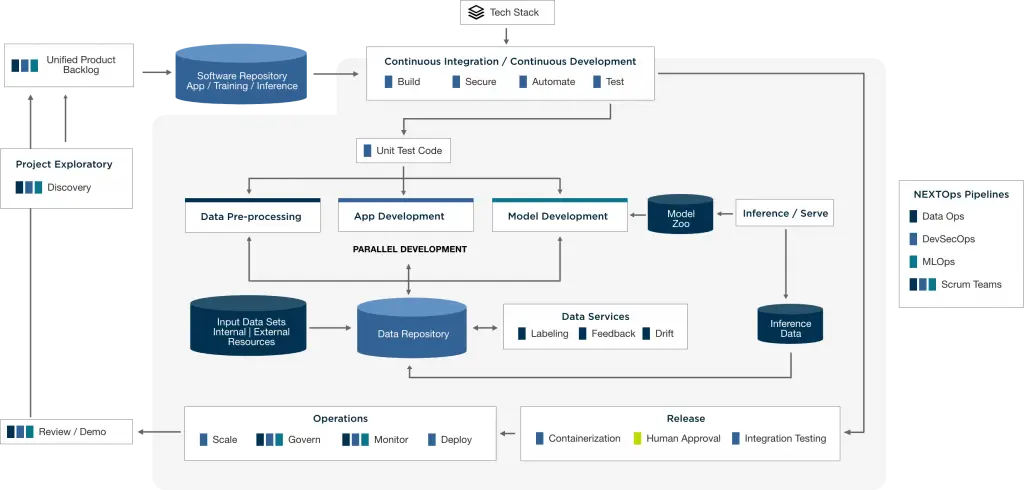Situation analysis
In today’s fast-paced and evolving development environment, manual processes that churn out software deployment, machine learning, software integration, and data engineering are cumbersome. And behind these manual processes are the people. Data engineers manage the data, data scientists create the models and algorithms, developers write the code, security engineers protect the systems, and the integration specialists push it all into production.
The result is siloed pipelines that slow missions with too many tools, too many manual processes, and worse, lack of communication.
To reduce this technical debt and propel your missions forward, you need a framework purpose-built for effective collaboration, reproducibility, efficiency, scalability, and security.
Ops to the Nth degree
Operations are elements that facilitate high-quality instances of business activities with minimal friction. These include the people, processes, tools, and infrastructure required to complete the activity.
In our experience, “Ops to the nth” isn’t enough for an organization. Solution delivery is often challenged by tool and platform incompatibility, security compliance and accessibility issues, integration mishaps, low-quality code, QA bottlenecks, and rework (also referred to as technical debt).
So, if the issue is siloed pipelines, it only makes sense to pull them together, right?
Agencies need an integrated framework that combines all teams and their respective moving parts into a single complementary delivery workflow. Only then can your organization effectively coordinate ongoing engineering and analytics efforts.
NEXTOps℠ simplifies and automates
NT Concepts built the NEXTOps framework to help agencies rapidly deploy solutions and scale to meet ever-growing and/or shifting mission needs. We know about taking operations to the next level. Our framework brings three key pipelines to work together like a well-oiled machine to fuel your missions with fast feedback and continuous delivery, leveraging modern agile practices together with evolving tools and technologies.
Our NEXTOps Framework creates a measurable workflow that drives collaboration, data acquisition, security, development, data science, deployment, and decision advantage. It underscores how all aspects of solution delivery should fit together—bringing transparency, repeatability, and clarity of purpose to analytic, engineering, and development projects.
How NEXTOps℠ works
Here is how the pipelines for Development Security Operations (DevSecOps), Data Operations (DataOps), and Machine Learning Operations (MLOps) function together with teams pulling work from a unified product backlog:
DevSecOps
DevSecOps facilitates agile best practices and combines software development, security controls, and operational capabilities. Application and infrastructure security are incorporated from the onset of every project and, more importantly, driven by automation.
With security and automation practices baked in, DevSecOps eliminates mistakes and reduce attacks and downtime in the data, software delivery, and machine learning pipelines.
DevSecOps helps diverse teams tackle projects of various sizes and types with a common set of end-to-end quality application development practices, consistent deployments, and repeatable infrastructure to enhance security and continuous testing.
DataOps
Data is the foundational element of advanced analytics, such as machine learning. The DataOps pipeline iteratively enhances data quality, literacy, and governance. It also creates an automated and continuous trusted data flow for DevSecOps and MLOps ingestion and use.
This benefits most organizations because data is often unlabeled, stored in disparate formats, and not optimally transformed for rapid ingestion into analytic pipelines.
MLOps
Machine learning isn’t a stand-alone data science exercise. Data, systems, and operations are inextricably linked to machine learning algorithms to ensure models are trained and validated appropriately. MLOps leverages DevSecOps and DataOps processes at every step: consuming the data, pre-processing, model training, and serving pipelines.
With MLOps, model development is iteratively run, and output continuously flows through the DevSecOps process for consistent deployments and maintenance
What NEXTOps℠ delivers that others can’t
Silos get bridged: Cross-functional ownership of operations trumps individual responsibilities—collaboration becomes the culture to support the larger goal of ensuring everything works more effectively and efficiently. NEXTOps reduces friction between teams and bolsters communication and collaboration. It integrates existing silos and prevents the birth of new ones.
Teams go agile: With a deeper understanding of the entire scope of operations, teams can rapidly respond to issues and efficiently work together towards a resolution. NEXTOps enables better speed to solution with developers, data engineers, data scientists, security engineers, and deployment teams integrating early, iteratively problem solving, and constantly communicating.
Automation is built in: NEXTOps brings consistency, traceability, uniformity, and repeatability for solution deployment through the continuous automation of all pipelines leveraging containers, microservices, continuous integration/continuous deployment (CI/CD) tools, and principles of infrastructure and configuration as code. Manual and error-prone steps are eliminated, enabling teams to concentrate on higher-value work.
Security is baked in: Security is automated and incorporated into each stage of the individual pipeline lifecycles, making security synonymous with development. Cross-functional teams work to automate security controls in compliance with OWASP Top 10 and the Department of Defense (DoD) Risk Management Framework (RMF). NEXTOps fosters a culture of coding with security in mind to continuously monitor and remediate any vulnerabilities or risks as early as possible, preventing disruption of the delivery cycle.
It’s fantastically elastic: NEXTOps allows for the organic growth of systems. Due to its holistic, unified architecture, it is primed for easy integration of additional pipelines such as DesignOps and ITOps. Conversely, operation pipelines can quickly be turned off. For instance, if during the project exploratory phase, you determine that your solution doesn’t require machine learning, you can switch off MLOps or reconfigure it to a lighter-weight analytic approach without interrupting any parallel workflows.
Technical debt is eliminated: Coupled with automation, modularity is integral to NEXTOps and ensures that new tools, steps, and processes are easily integrated as others get sunset. Modularity also ensures portability and keeps the tools and technologies environment-friendly. With NEXTOps, a shared, governed tech stack of industry-leading tools, together with best practices for process, architectural and coding patterns, reduce the time and difficulty of pushing solutions into production.
NEXTOps℠ for a data-driven enterprise
A shared understanding of mission objectives and the seamless integration of data, technology, and science is imperative to the success of any data-driven enterprise. With NEXTOps, the beginning-to-end orchestration of data, process, security, tools, code, environments, and teams is possible. NEXTOps integrates key organizational pipelines to facilitate repeatability, modularity, automation, security, and scalability of technology solutions to mission-relevant problem sets—with minimized technical debt.

